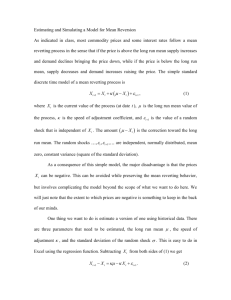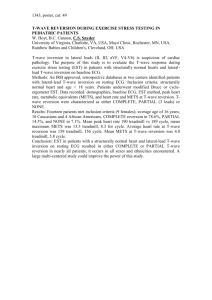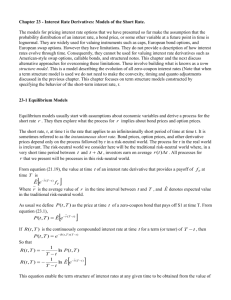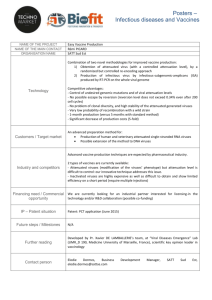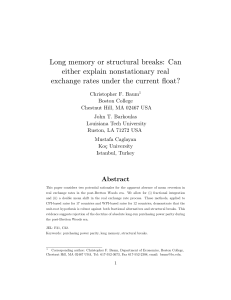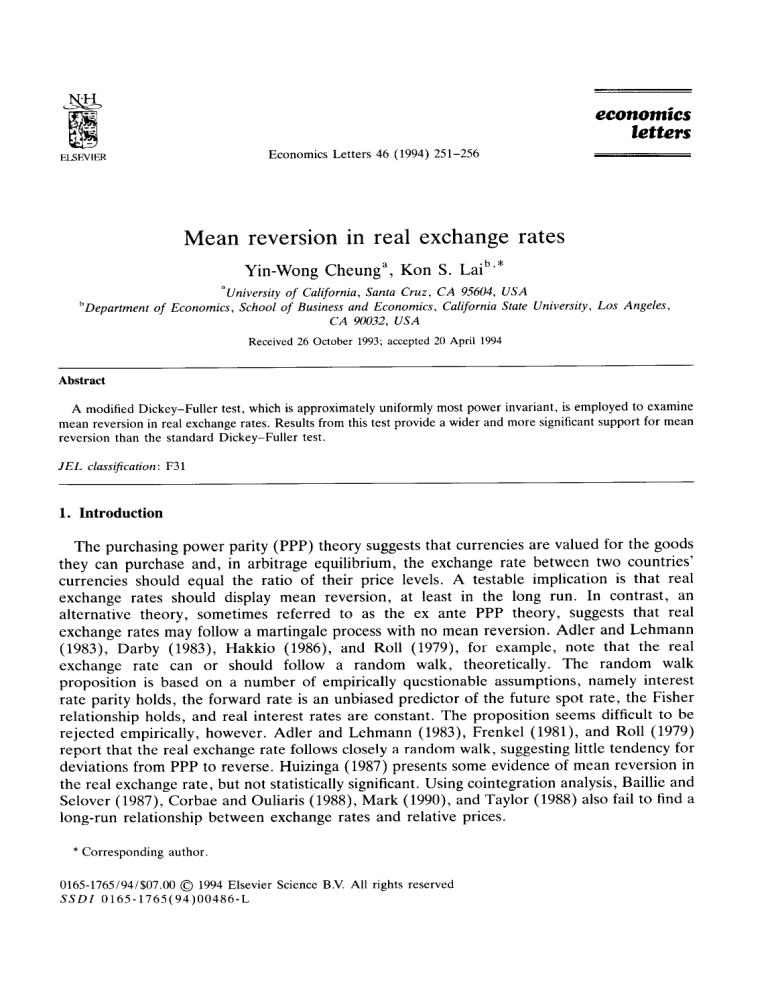
-
economics
letters
Economics
Mean reversion
Yin-Wong
Letters
46 (1994) 251-256
in real exchange
Cheung”,
Kon
rates
S. Laib’*
=lJniversity of California, Santa Cruz, CA 95604, USA
bDepartment of Economics, School of Business and Economics, California State University, Los Angeles,
CA 90032, USA
Received 26 October 1993; accepted 20 April 1994
Abstract
A modified Dickey-Fuller
test, which is approximately
uniformly most power invariant, is employed to examine
mean reversion in real exchange rates. Results from this test provide a wider and more significant support for mean
reversion than the standard Dickey-Fuller
test.
JEL
classification: F31
1. Introduction
The purchasing power parity (PPP) theory suggests that currencies are valued for the goods
they can purchase and, in arbitrage equilibrium,
the exchange rate between two countries’
is that real
currencies
should equal the ratio of their price levels. A testable implication
exchange
rates should display mean reversion,
at least in the long run. In contrast,
an
alternative
theory,
sometimes
referred
to as the ex ante PPP theory,
suggests that real
exchange rates may follow a martingale process with no mean reversion. Adler and Lehmann
(1983), Darby (1983), Hakkio (1986), and Roll (1979), for example,
note that the real
exchange
rate can or should follow a random
walk, theoretically.
The random
walk
proposition
is based on a number of empirically
questionable
assumptions,
namely interest
rate parity holds, the forward rate is an unbiased predictor of the future spot rate, the Fisher
relationship
holds, and real interest rates are constant. The proposition
seems difficult to be
rejected empirically,
however. Adler and Lehmann (1983), Frenkel (1981), and Roll (1979)
report that the real exchange rate follows closely a random walk, suggesting little tendency for
deviations from PPP to reverse. Huizinga (1987) presents some evidence of mean reversion in
the real exchange rate, but not statistically significant. Using cointegration
analysis, Baillie and
Selover (1987), Corbae and Ouliaris (1988), Mark (1990), and Taylor (1988) also fail to find a
long-run relationship
between exchange rates and relative prices.
* Corresponding
author.
016%1765/94/$07.00
0 1994 Elsevier
SSDI 0165-1765(94)00486-L
Science
B.V. All rights reserved
252
Y.-W.
Cheung,
K.S.
Lai
I Economics
Letters 46 (1994) 251-256
Hakkio (1986) observes that the empirical failure to find mean reversion in real exchange
rates can be due to the low power of standard unit-root tests. Mishkin (1984) and Cumby and
Obstfeld (1984) report that ex ante PPP can be rejected when a joint test with some other
proposition
is considered.
More recently,
Abuaf and Jorion (1990) address the low-power
problem by estimating unit-root regression equations jointly and they find mean reversion in
real exchange
rates. Diebold et al. (1991) employ fractional
unit-root
analysis and report
evidence of mean reversion in real exchange rates under the gold standard. The Diebold et al.
analysis can raise the power of the test for mean reversion by allowing for a wider range of
mean reversion than standard unit-root tests (see also Cheung and Lai, 1993). All these results
appear to support that standard unit-root tests have low power to detect mean reversion.
This paper further examines the mean-reverting
behavior of real exchange rates by using a
new unit-root
test devised by Elliot et al. (1992). Their study analytically
derives the
asymptotic
power envelope
for unit-root
tests. They propose a simple modification
of the
augmented
Dickey-Fuller
(1979) test such that the modified test, called the DF-GLS’
test,
can nearly achieve the power envelope. The DF-GLS’
test is also shown to be approximately
uniformly most power invariant. Monte Carlo results reported by Elliot et al. (1992) indicate
that the power improvement
of the modified Dickey-Fuller
test can be quite large and that it
exhibits good size and size-adjusted
power properties
in finite samples with dependent
errors.
The paper is organized
as follows. Section 2 describes the data. Section 3 discusses the
statistical procedure
used, and Section 4 contains the empirical results. Section 5 concludes.
2. The data
The data under study are annual real exchange
rate data constructed
from nominal
exchange rates and national price levels measured by both consumer prices indexes (CPIs) and
wholesale price indexes (WPIs). Data from nine countries are considered,
and they include
Canada, France, Germany,
Italy, Japan, Netherlands,
Switzerland,
the United Kingdom, and
the United States. The data sample covers the period from 1900 through 1992, except for the
WPI series for Switzerland,
which is available from 1914 to 1992. Data on annual exchange
rates and WPIs for the period 1900-1972 are taken from Lee (1978), whereas the annual CPIs
from 1900 to 1989 are drawn from Maddison
(1991). These three sets of data series are
updated
and extended
to 1992 using annual data taken from the International
Monetary
Fund’s Znternational Financial Statistics data tape. There are in total 16 real exchange rate
series against the U.S. dollar: eight series of CPI-based
real exchange rates and eight other
series for WPI-based
real exchange rates. Following the practice in previous studies, all data
series under examination
are expressed in natural logarithms.
3. A modified Dickey-Fuller
test
In testing for a unit root in an autoregressive
(AR) model that allows for a linear time trend,
Elliot et al. (1992) show that a modified Dickey-Fuller
test, referred to as the DF-GLS’
test,
is approximately
uniformly most power invariant (UMPI) while strictly no UMPI test exists.
253
Y.-W. Cheung, K.S. Lai I Economics Letters 46 (1994) 251-2.56
These authors explicitly derive the asymptotic power envelope by analyzing the sequence of
Neyman-Pearson
tests of the unit-root null hypothesis (a = 1) against the local alternative
of
ti = 1 + c/T in the finite-sample
Gaussian AR(p + 1) model, in which T is the sample size and
C is some fixed constant. On the basis of the asymptotic power calculation,
Elliot et al. (1992)
establish that the DF-GLS’
test can achieve a substantial
gain in power over conventional
unit-root tests. In addition, the DF-GLS’
test displays good power and little size distortion in
finite samples with dependent
errors.
Let {y,) be the data process under examination.
The DF-GLS’
test is carried out based on
the following regression:
where L is the usual lag operator
alternative
of &, is given by
y; = y, -
p”‘q
9
and y:, the locally
detrended
data process
under
the local
(2)
with z, = (1, t)’ and p” being the regression coefficient of y”, on Zr, for which (y”, , y”2, . . . , y”,) =
(yl, (1 - ‘YL)y*, . . . , (1 - ‘YL)y.) and (Z1, ZZ,. . . , 2,) = (z,, (1 - cUL)z,, . . . , (1 - (YL)zT).
The DF-GLS’
test statistic is given by the usual t-statistic testing a, = 0 against the alternative
of a, < 0 in regression
(1). Elliot et al. (1992) recommend
that the parameter
F, which is
responsible
for defining the local alternative
through Cr = 1 + C/T, be set equal to -13.5.
Critical values for the DF-GLS’
test statistic are provided by Elliot et al. (1992, Table 1)
using the Monte Carlo method.
4. Empirical
results
To illustrate the possible difference in test results between the standard Dickey-Fuller
test
and the modified Dickey-Fuller
test, all the series of real exchange rates are each first checked
for mean reversion using the augmented
Dickey-Fuller
(ADF) test with a linear time trend.
The statistical results of the ADF test are reported in Table 1. The lag length used for the
ADF test is determined
using a model selection
procedure
based on both the Akaike
information
criterion (AIC) and the Schwarz information
criterion (SIC). For the CPI-based
real exchange rate series, in only two cases (France and Germany)
out of the eight cases
under consideration
can we find significant evidence of mean reversion.
Similar results apply
to the WPI-based real exchange rate series, for which the null of a non-stationary
process can
be rejected in just two cases (France and Japan). Hence, in accordance with previous findings,
the ADF test finds little evidence of mean reversion in real exchange rates.
Table 2 contains the statistical results for the DF-GLS’
test, which has been shown by
Elliot et al. (1992) to be more powerful than the ADF test. The lag order used for this test is
again selected based on both the AIC and SIC. For the CPI-based real exchange rate series,
significant evidence in favor of mean reversion can be obtained in five out of eight cases at the
5% level or better. For the WPI-based real exchange rate series, evidence of mean reversion
254
Y.-W. Cheung,
Table 1
Results of the standard
augmented
Country
series
K.S. Lai i Economics
Dickey-Fuller
Letters 46 (1994) 251-256
test
ADF
statistic
SIC
lag
ADF
statistic
(a) CPI-based real exchange rates
Canada
1
France
4
Germany
1
Italy
1
Japan
1
Netherlands
2
Switzerland
2
United Kingdom
2
-2.9790
-4.3012**
-11.6907**
-3.4397
-3.1588
-2.5777
-3.0393
-3.2140
1
1
1
1
1
2
2
2
-2.9790
-3.6633*
-11.6907**
-3.4397
-3.1588
-2.5777
-3.0393
-3.2140
(b) WPK-based real exchange rates
Canada
4
France
3
Germany
1
Italy
1
Japan
2
Netherlands
1
Switzerland
2
United Kingdom
2
-3.4481
-4.8396**
-2.3656
-3.2975
-4.4638**
-3.1814
-3.1271
-3.3205
4
1
1
1
2
1
2
2
-3.4481
-4.4151**
-2.3656
-3.2975
-4.4638**
-3.1814
-3.1271
-3.3205
AIC
lag
Notes: For T = 100, the critical values for the ADF test at the 5% and 1% levels are given by -3.45
respectively.
Statistical significance is indicated by an asterisk (*) for the 5% level and a double asterisk
1% level.
can be found in all but one case at the 5% level or better. In general,
apparently
much more supportive
of mean reversion
in real exchange
obtained
based on the usual ADF test.
and -4.04,
(**) for the
these results are
rates than those
5. Conclusion
While the PPP theory implies the presence of mean reversion
in real exchange
rates, a
competing
theory of ex ante PPP suggests that real exchange rates can, or should be, not
mean-reverting.
Previous
analyses of the behavior
of real exchange
rates using standard
unit-root tests have mostly failed to detect mean reversion. The empirical failure to find mean
reversion in real exchange rates does not lead to an outright rejection of PPP and acceptance
of ex ant PPP, but rather they may just reflect the low power of the unit-root tests applied.
This study explores the relevance of the explanation
based on low statistical test power. The
DF-GLS’
test recently
developed
by Elliot et al. (1992) is employed
to test for mean
reversion
in real exchange rates for the period 1900-1992. This modified Dickey-Fuller
test
can be shown to be approximately
UMPI and is much more powerful than usual unit-root
tests. The improvement
in test power is shown to be important for a proper evaluation
of the
mean-reverting
behavior of the real exchange rate. It is found that the modified Dickey-Fuller
Table 2
Results of the modified
Y.-W. Cheung,
K.S. Lai I Economics
Dickey-Fuller
test
Letters 46 (1994) 251-256
255
DF-GLS’
statistic
lag
DF-GLS’
statistic
(a) CPI-based real exchange rates
Canada
1
France
4
Germany
1
Italy
1
Japan
1
Netherlands
2
Switzerland
2
United Kingdom
2
-2.8836
-4.2990**
-11.3828**
-3.3124*
-3.1263*
-2.4531
-2.9582
-3.1314*
1
1
1
1
1
2
2
2
-2.8836
-3.5493*
-11.3828**
-3.3124*
-3.1263*
-2.4531
-2.9582
-3.1314*
(b) WPI-based real exchange rates
Canada
4
France
3
Germany
1
Italy
1
Japan
2
Netherlands
1
Switzerland
2
United Kingdom
2
-3.4141*
-4.7623**
-2.2672
-3.2859*
-4.3771**
-3.1117*
-3.0569*
-3.1756*
Country
series
AIC
lag
SIC
-3.4141*
-4.3201**
-2.2672
-3.2859*
-4.3771**
-3.1117*
-3.0569*
-3.1756*
Notes: For T= 100, the critical values for the DF-GLS’
test at the 5% and 1% levels are given by -3.03 and
-3.58, respectively
(Elliot et al., 1992). Statistical significance is indicated by an asterisk (*) for the 5% level and a
double asterisk (**) for the 1% level.
test with improved power can yield results rather different from those obtained based on the
standard
Dickey-Fuller
test. In comparison
with the results obtained
from the standard
Dickey-Fuller
test, those obtained from the DF-GLS’
test are shown to be considerably
more favorable to the hypothesis of mean reversion,
and the DF-GLS’
test results provide,
accordingly,
a wider and more significant support for mean reversion in real exchange rates.
References
Abuaf, Niso and Phillippe Jorion, 1990, Purchasing power parity in the long run, Journal of Finance 45, 157-174.
Adler, Michael and Bruce Lehmann,
1983, Deviations from purchasing power parity in the long run, Journal of
Finance 38, 1471-1487.
Baillie, Richard T. and David D. Selover,
1987, Cointegration
and models of exchange
rate determination,
International
Journal of Forecasting
3, 43-51.
Cheung, Yin-Wong and Kon S. Lai, 1993, A fractional cointegration
analysis of purchasing power parity, Journal of
Business and Economic Statistics 11, 103-112.
Corbae, Dean and Sam Ouliaris, 1988, Cointegration
and tests of purchasing power parity, Review of Economics
and Statistics 70, 508-511.
Cumby, Robert and Maurice Obstfeld,
1984, International
interest rate and price level linkages under flexible
exchange rates: A review of recent evidence, in: John Bilson and Richard Marston, eds., Exchange rate theory
and practice (University
of Chicago Press, Chicago).
256
Y.-W.
Cheung,
K.S.
Lai
I Economics
Letters
46 (1994) 251-256
Darby, Michael R., 1983, Movements
in purchasing power parity: The short and long runs, in: Michael R. Darby
et al., eds., The international
transmission
of inflation (University
of Chicago Press, Chicago) 462-477.
Dickey, David A. and Wayne A. Fuller, 1979, Distribution
of the estimators
for autoregressive
time series with a
unit root, Journal of American
Statistical Association
74, 427-431.
Diebold, Francis X., Stephen Husted and Mark Rush, 1991, Real exchange rates under the gold standard, Journal
of Political Economy 99, 1252-1271.
Elliott, Graham, Thomas J. Rothenberg
and James H. Stock, 1992, Efficient tests for an autoregressive
unit root,
National Bureau of Economic
Research Technical Working Paper No. 130, December.
Frenkel, Jacob A., 1981, The collapse of purchasing power parities during the 1970’s, European
Economic Review
16, 145-165.
Hakkio, Craig S., 1986, Does the exchange rate follow a random walk? A Monte Carlo study of four tests for a
random walk, Journal of International
Money and Finance 5, 221-229.
Huizinga, John, 1987, An empirical investigation
of the long-run behavior of real exchange rates, in: K. Brunner
and A. Meltzer, eds., Carnegie-Rochester
conference
series on public policy 27, 149-214.
Maddison,
Angus, 1991, Dynamic forces in capitalist development
(Oxford University
Press, New York).
Mark, Nelson C., 1990, Real and nominal exchange rates in the long run, Journal of International
Economics
28,
115-136.
Mishkin, Frederic,
1984, Are real interest rates equal across countries? An empirical investigation
of international
parity conditions,
Journal of Finance 39, 1345-1357.
Roll, Richard,
1979, Violations
of purchasing
power parity and their implications
for efficient international
finance and trade (Ballinger,
commodity
markets,
in: Marshall Sarnat and Giorgio Szego, eds., International
Cambridge,
MA).
Taylor,
Mark P., 1988, An empirical
examination
of long run purchasing
power parity using cointegration
techniques,
Applied Economics
20, 1369-1381.


